Meicaikourou 梅菜扣肉 is a well-known Hakka 客家 signature dish. Often eaten during Chinese New Year, Meicaikourou 梅菜扣肉 is served as a mound of soft, succulent slices of pork belly on top of stewed mustard leaves called Meicai 梅菜. This post not only provides you with the recipe, but also the history of this 1700 year old recipe that dates from the 4th century AD, and the migration of Han Chinese into southeastern China to form today’s Hakka 客家 people.
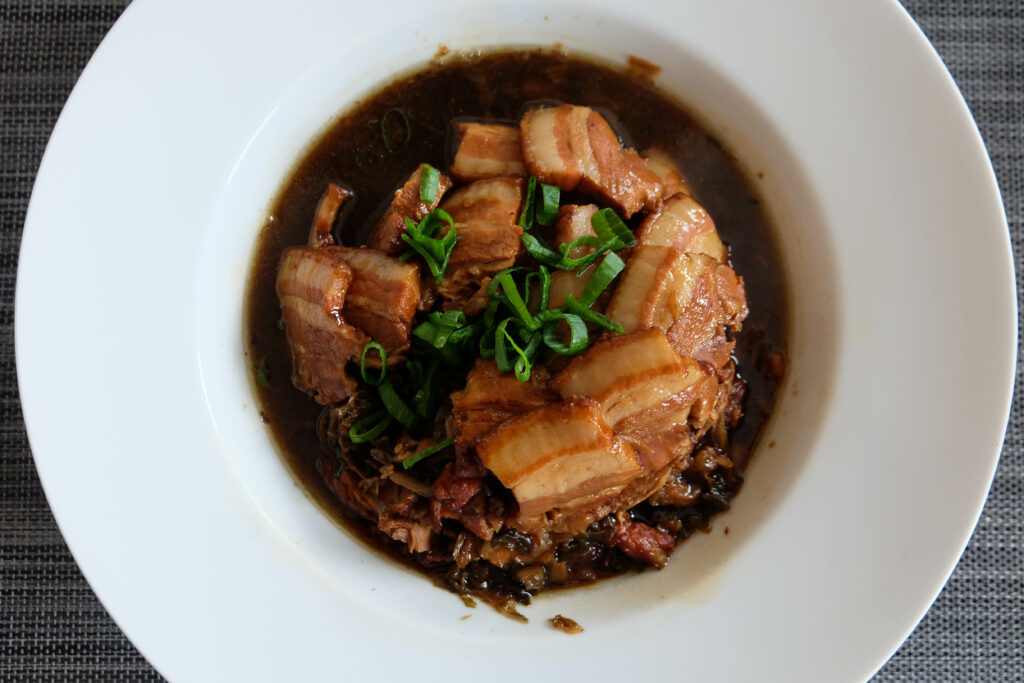
Who are the Hakkas 客家?
The Hakkas 客家 are a group of Han Chinese people who now live in the mountainous border regions of Guangdong (Canton) and Fujian provinces. They are also located in smaller communities in Taiwan, Sichuan as well as in the Chinese diaspora in Southeast Asia such as Singapore, Malaysia and Thailand.
For those who didn’t know: The Hans 汉/漢 are the largest and the only major ethnic group of China. Their ethnic identity and culture form the core of what is known in the west as Chinese culture. Prior to the influence of western notion of nation-state, only ethnic Hans were considered persons of ‘Chinese origin’. This belief is unofficially upheld until today.
The name ‘Hakka’ 客家 is an exonym, meaning ‘guest people‘. This was the name given by the local Cantonese to these incoming Han migrants, who migrated to the harsh, infertile mountain regions around 311 AD.
While Canton and Fujian provinces were sinified by the first Chinese Emperor Qin Shi Huang in the 3rd century BC, the descendants of earlier Han Chinese mixed with local Austronesians (who can still today be found on the island of Taiwan) to become Cantonese and Minnan “Hokkien” people.
With the Disaster of Yongjia 永嘉之乱 in 311 AD, northern China fell to the Mongolic Xiongnu forces, and many people fled to the south to seek safety. This Han migration took place in the two or three centuries that followed in about five waves.
Despite reaching safety in the south, these Han Chinese refugees were not welcomed by the local half-Han half-Austronesian Cantonese and Hokkien peoples.
This is because the only fertile areas of China’s southeastern coast are along the shoreline, and these were preciously guarded by the locals. This kept the Hakkas up in the mountains where the soil cannot be used for agriculture and were the home of bandits and outlaws. This is the reason why the Hakka built their gigantic circular fortress community houses called “Tulou” 土楼, as featured in Disney’s 2020 live action film Mulan.
A note about the Hakka 客家 language and culture
The Hakkas are not considered by today’s Chinese authorities as a racial minority, although they speak their own form of Chinese language called ‘Hakka’ 客家 that is not intelligible to modern speakers of Mandarin Chinese. This is because they are truly Han Chinese isolated since the 4th-7th centuries AD.
Linguists found that the Hakka language most resemble the form of Old Mandarin Chinese spoken in Chang’an 长安 – former capital of China, today’s Xi’an 西安 – at the beginning of the Tang Dynasty (early 7th century AD).
If we were to transport a modern-day Hakka person and a modern-day Xi’an person back to Chang’an in the 4th century, the Hakka person would understand half of everything said while the Xi’an person none at all.
Most notably, the pronunciation and words in Hakka for ‘I, you, he‘ are ‘爾、吾、其’ in Tang-dynasty Mandarin Chinese, compared with today’s Beijing-based Mandarin Chinese ‘我、你、他’.
However, this is nothing special in that region of China.
Cantonese is a form of Old Chinese spoken in the Jin dynasty (3rd century AD), while Minnan is a mixture of Austronesian words and Ancient Chinese from the 4th century BC!
But the cultural differences between the pure Han Chinese culture of the Hakkas and the Austronesian mix of the Cantonese and the Hokkiens remained stark.
In his journal, a 12th-century school teacher (most likely a Han Chinese himself) called Chen Yixin 陈一新 wrote that:
“闽有八郡, 汀邻五岭,然风声气习颇类中州”
“In Min (today’s Fujian province) there are eight counties. The Ding County (where the Hakkas reside) is the only one like the Central Plains.”
This shows that even by the 12th century, the Hakkas still retained their ‘Chineseness’ – that is recognisable by the other Han Chinese – as opposed to the locals.
What is Meicai 梅菜?
Sometimes also called Meigancai 梅干菜/梅乾菜, Meicai is a form of dried, pickled core of mustard plants produced by the Hakkas in the counties of Meizhou 梅州 and Huizhou 惠州 in the Guangzhou Province/Canton.
It is NOT a plant on its own called Meicai, as often misunderstood by outsiders. But rather, it is named after the county of Meizhou where it was first produced. Today, it is Huizhou that makes the best Meicai pickles.
The production of this pickled mustard core is related to the hostile mountainous habitats of the Hakkas.
Because the terrains cannot be used for agriculture, all foods are used and nothing is wasted. The core of old mustard plants taste bitter while the outer leaves can be eaten fresh. Hence the core and the stem get pickled and become the ingredient called Meicai, used everywhere in Hakka dishes.
Funny enough, Meicai 梅菜 is not called Meicai in Hakka. It is simply ‘Ham Choi Gon‘ 醎菜乾 – dried pickled vegetable! It is only called ‘Muichoi‘梅菜 when sold to the Cantonese to indicate that it was a pickled vegetable from Meizhou.
How do you say Meicaikourou 梅菜扣肉 in Hakka?
Just like their own name ‘Hakka‘ which is an exonym, this signature Hakka dish Meicaikourou 梅菜扣肉 is not called like this in Hakka Chinese.
The rest of China only knew about this rural Hakka dish through the Cantonese, who gave it a Cantonese name ‘Muichoikauyok‘ 梅菜扣肉.
This became transliterated into modern Mandarin Chinese as ‘Meicaikourou‘ 梅菜扣肉.
In Hakka Chinese however, the dish is known as ‘Ham Choi Gon Sam Tsen Ngiuk‘ 醎菜乾三层肉: dried pickled vegetables and fatty pork!
Why is Meicaikourou 梅菜扣肉 an ancient Han Chinese dish?
The preparation process of Meicaikourou 梅菜扣肉 displays a sophisticated understanding of the ingredients and culinary excellence:
the wrinkled texture of the pork rind created by the charring, cooking, frying then steaming shows you that the inventor knew exactly how to create a certain look and texture of the pork. The ingenious idea of having the essence of pickled mustard flow into the meat and the fats in a slow steaming process also reveals an understanding of pairing of ingredients and tastes. The serving through an inverted bowl to create a mound, also shows you this is not a rural unsophisticated food culture.
The intricate process of this very simple dish, betrays a highly developed food culture from the original 4th-century Han Chinese heartland in the central plains of China.
Traditionally, southern Chinese cuisines are far more sophisticated than northern Chinese cuisines. This is because northern Han Chinese have suffered two thousand years of repeat incursions, invasions and migrations of Mongolic and Turkic nomads from the northern steppes. Because of the constant warfare, food, language and habits get lost. It is likely that Meicaikourou 梅菜扣肉 is an ancient Han dish that is, like the Hakka language and culture, a snapshot of the earlier Han Chinese food culture.

The Sichuan variant: Xianshaobai 咸烧白
Despite having settled in the south for more than a thousand years, life remained hard for the Hakkas.
By the time the Mongol rulers were driven out in 1368, Han Chinese got to rule their own country again then until 1644 in the period called the Ming Dynasty. At this time, Han Chinese populations were depleted under the ruthless Mongols, and the Ming Rulers called for Han migrants to populate the outlying regions of Sichuan and Taiwan. The Hakkas took the call, as this was a ticket out of their hostile environment.
A group of Hakkas moved to Taiwan – then a newly-colonised island opposite Fujian filled with cannibalistic Austronesian tribes – where they have remained ever since.
Another group moved to Sichuan, where they became known as the ‘Cantonese‘ (they were not, but because they physically came from Canton and because they didn’t actually called themselves Hakka).
The Sichuan Hakkas exported this dish there and it became known there under another name: Xianshaobai 咸烧白
This Sichuan variant of Meicaikourou 梅菜扣肉 has Sichuan peppercorn in the broth as well as chilli peppers in the cooked pickles. Also, they use another pickle called Yacai 芽菜.
Now that you know everything about the Hakka people and the story of the dish Meicaikourou 梅菜扣肉, here is the recipe.
Ingredients:
- 500g pork belly with skin (without bones) at least 8cm wide
- 300g (6 bunches) Hakka pickled mustard leaves, Meicai 梅菜
- 200ml Shaoxing wine
- 4cm fresh ginger, skinned and sliced
- 4cm fresh ginger, skinned and finely diced
- 3 cloves of garlic, finely diced
- 1 spring onion
- 2 tbs sugar
- 2 tbs dark soy sauce
- 2 tbs light soy sauce
- 2 tbs oyster sauce
- 1 tsp salt
- Frying oil
- Water
- Optional: 2 tsp potato starch (see tip)
- Garnish: chopped spring onion, sprigs of coriander
Serving: 4 persons
Instructions:
- Wash your Meicai mustard leaves several times to get rid of the salt and leave it to soak in water for at least 30 minutes.
- Once done, squeeze out the water and drip dry.
- Heat up a dry wok to medium heat, and with the pork belly’s skin facing down, char the skin until it is cooked. This step is to get rid of the excess hair and to rid the skin of bad smell.
- Wash your pork belly in water to get rid of any remaining charred hair.
- Heat up a pot of water and bring to boil. Add in sliced ginger, whole spring onion tied into a knot, Shaoxing wine, and your pork belly. Let it simmer on low heat for 30 minutes. This step is to thoroughly cook the meat and get rid of any smell of blood.
- Remove and drip dry for 10 minutes. Save the pot of water for later use.
- In a large bowl, use a brush to darken the skin with dark and light soy sauces. Save the bowl with soy sauces for later use.
- In a deep fryer or using a normal pot with frying oil, heat up to medium heat and fry the pork belly faced down for about 5 minutes or until it is crispy. This is the first step to creating the ‘wrinkled skin effect’. Remove and drip dry for 10 minutes.
- Bring to boil your pot of water used just now. Let the pork belly cooked for 10 minutes in the broth before taking it out and letting it drip dry. This is the second step to creating the ‘wrinkled skin effect’. Save the pot of water for later use.
- Chop up your soaked Meicai mustard leaves.
- Heat up a wok with 4 tbs of vegetable oil. Stir-fry diced garlic, ginger, and chopped mustard leaves until soft. Add in the rest of your soy sauces, oyster sauce, salt, sugar and around 400ml of water (from previous pot). Bring everything to boil, then turn off the fire and leave aside.
- Slice your pork belly with a very sharp knife in at most 1cm-thick slices.
- In a large steam-proof bowl (or in slow-cooker pot, see below), lay the pork belly slices against the bottom and sides of the bowl in concentric circles like flower petals. Once done, pour the cooked mustard leaves and sauce into the bowl.
- In a steamer or a wok with a steamer stand, fill with water and bring to boil. Please the bowl in there to steam for 10 minutes then turn to low heat and steam for 2 hours.
- To serve, place a large serving plate (with enough depth for the sauce) over the bowl and turn it over. You may want to do it over a sink.
- Serve your Meicaikourou 梅菜扣肉 garnished with chopped spring onion and/or coriander.
Using a slow cooker
If you are like me, I don’t like to use the steamer for hours of steaming as that would steam up the house. You can also use a slow cooker to make this dish.
The only difference is while steaming adds moisture to the sauce, slow-cooking takes moisture away. So you will need to top up with sauce with leftover water from cooking the pork to near the brim of the slow cooker pot. Let the slow cooker cook for around 4 hours to achieve maximum softness of the pork belly.
Tips:
To make a thick sauce: Drain your sauce into a wok after turning the bowl over onto the serving plate. Bring it to boil and thicken it with a starch solution of potato starch and 100ml water. Stir and thicken the sauce. Pour over the pork and serve.
Width of pork belly: It’s ok if your pork belly is not as wide as 8cm. Where I live in Europe I can only get them at 5cm, and they shrink further after cooking.
Thickness of the slices: Some people may prefer thicker slices, like 2cm. Then you may need to steam for another 15 minutes to have it absolutely soft.
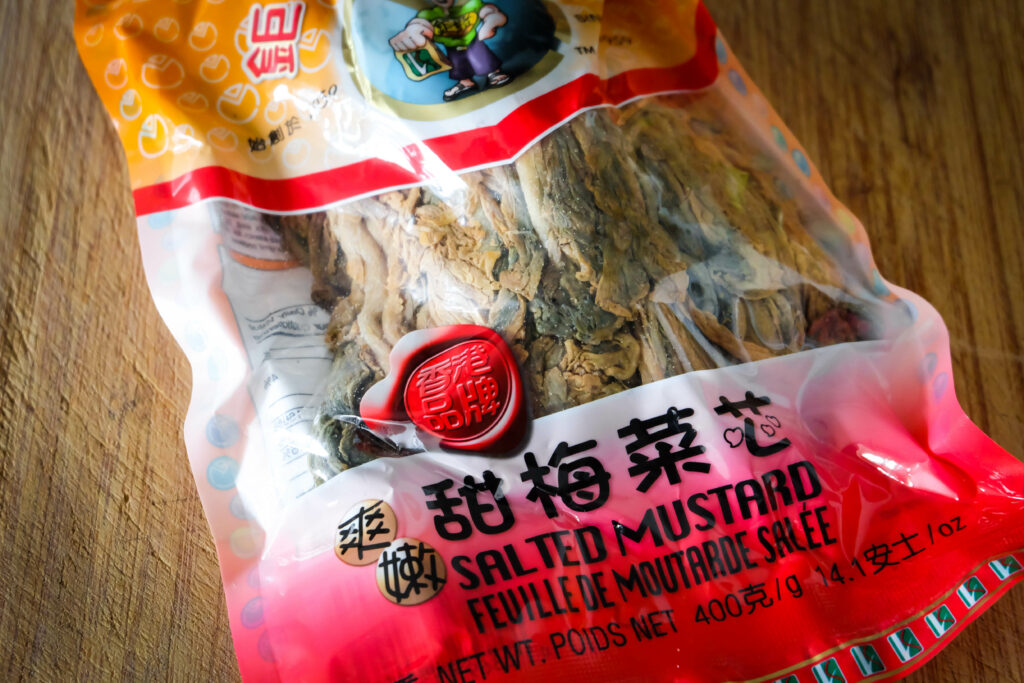
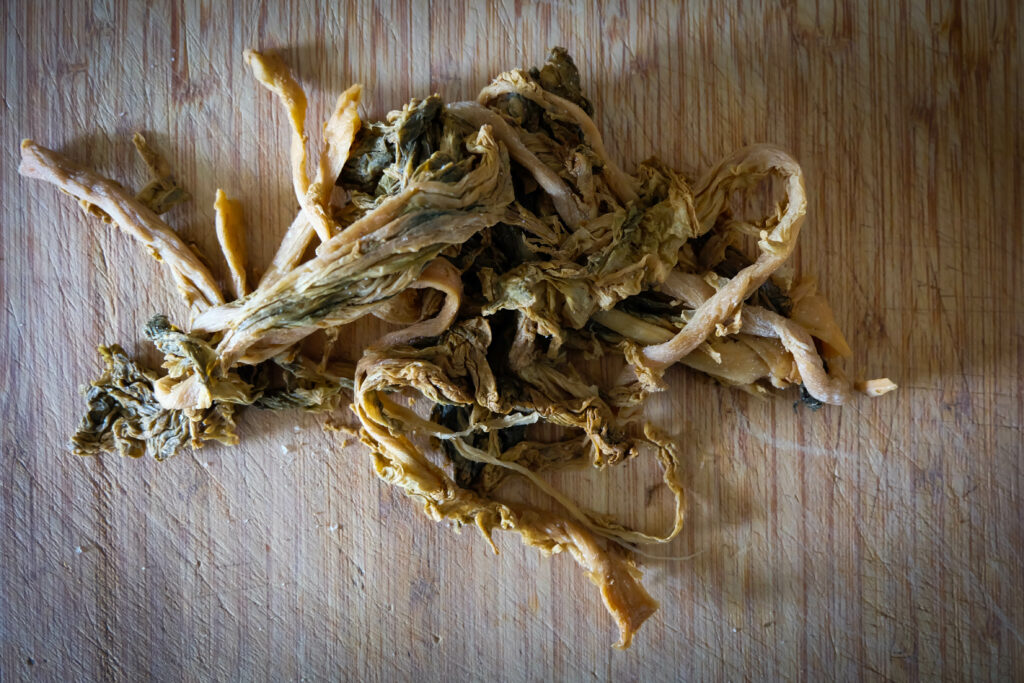

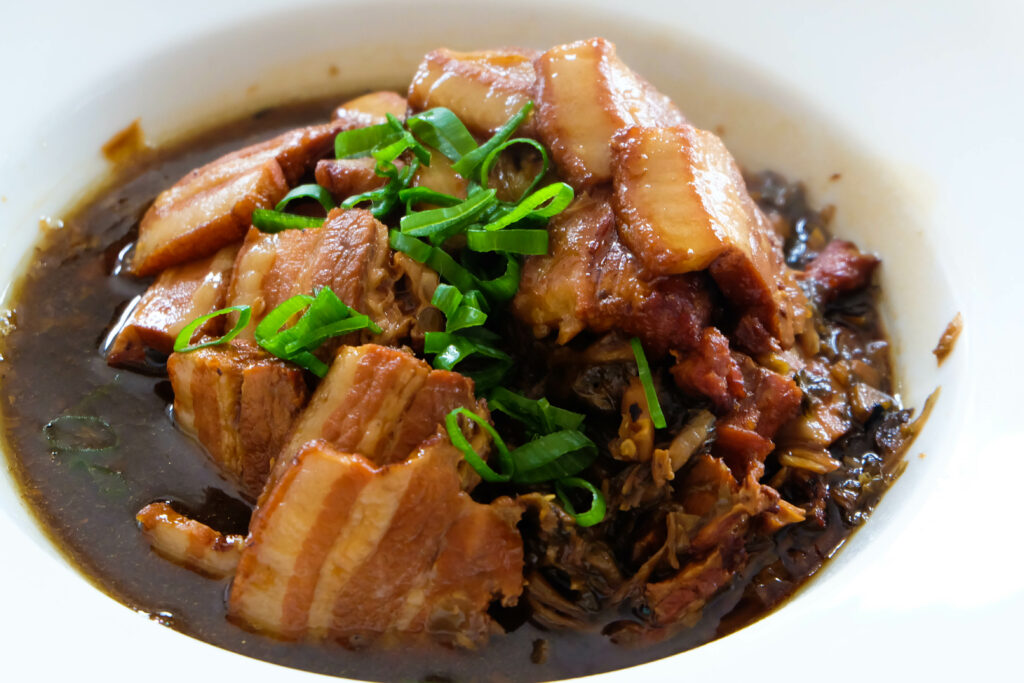
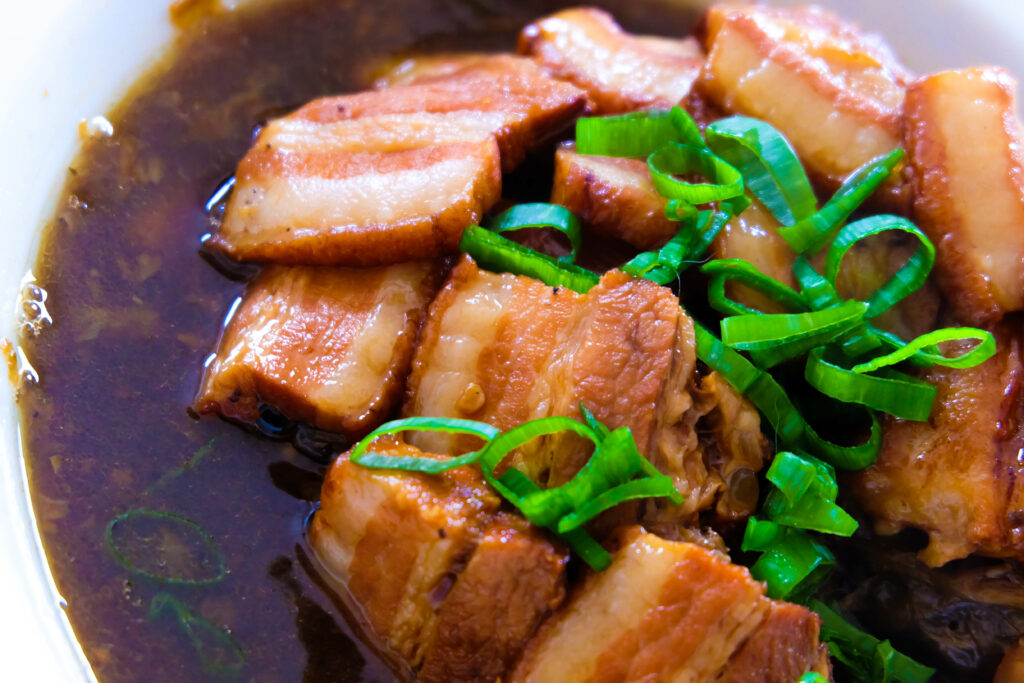

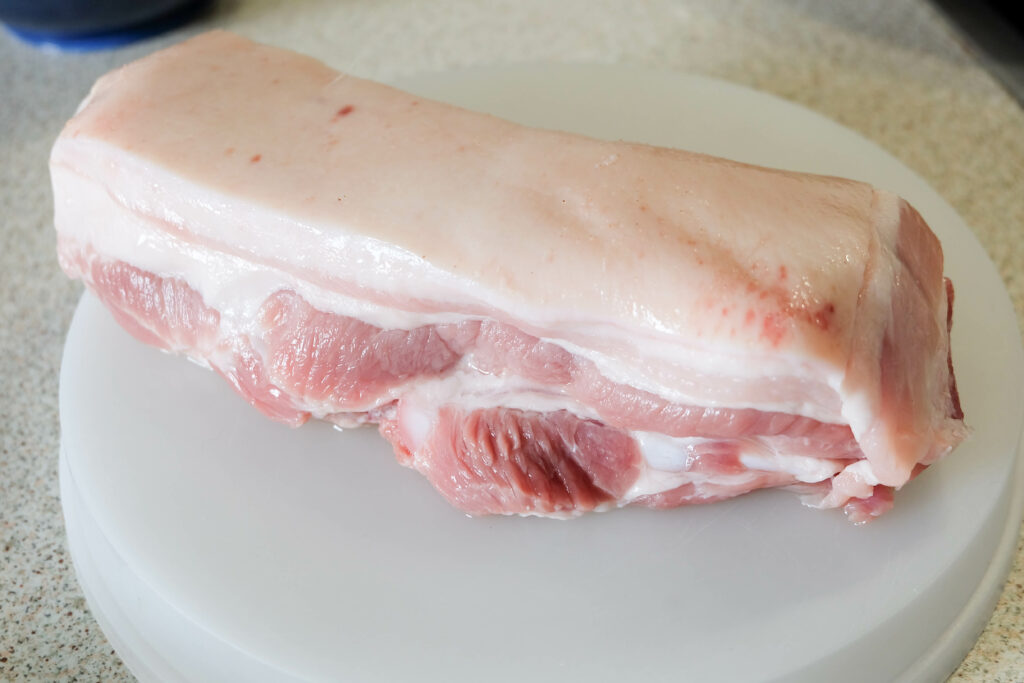
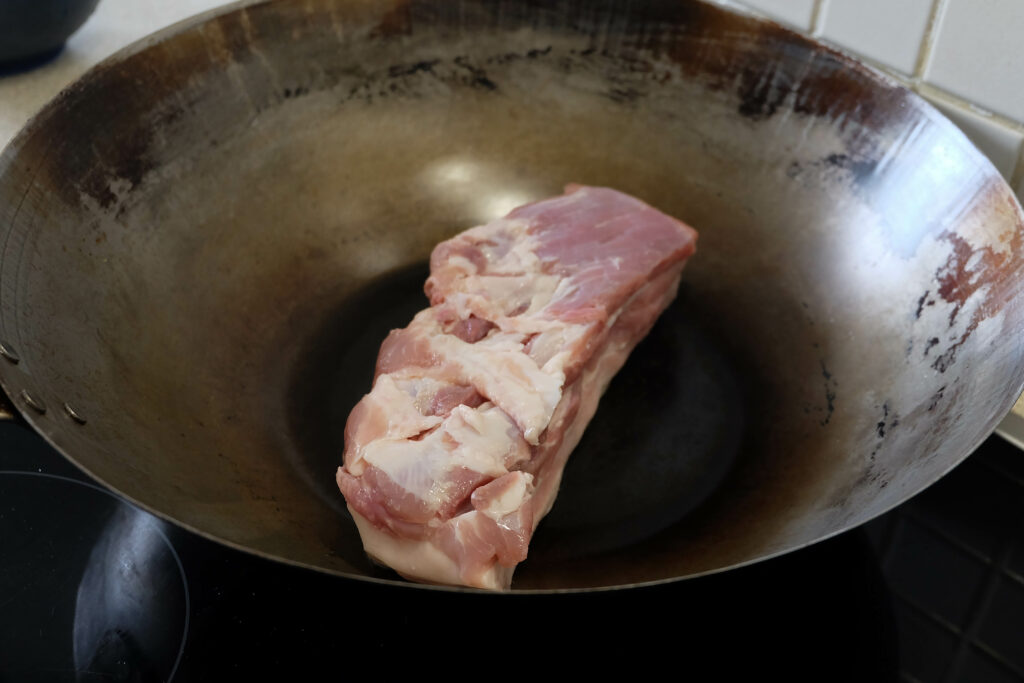
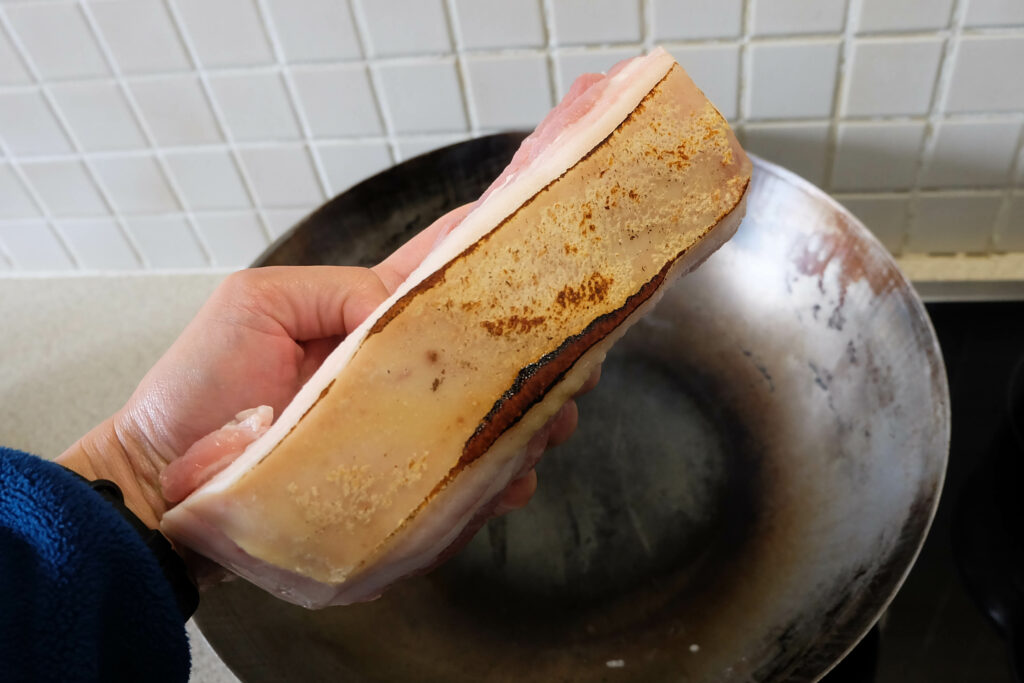
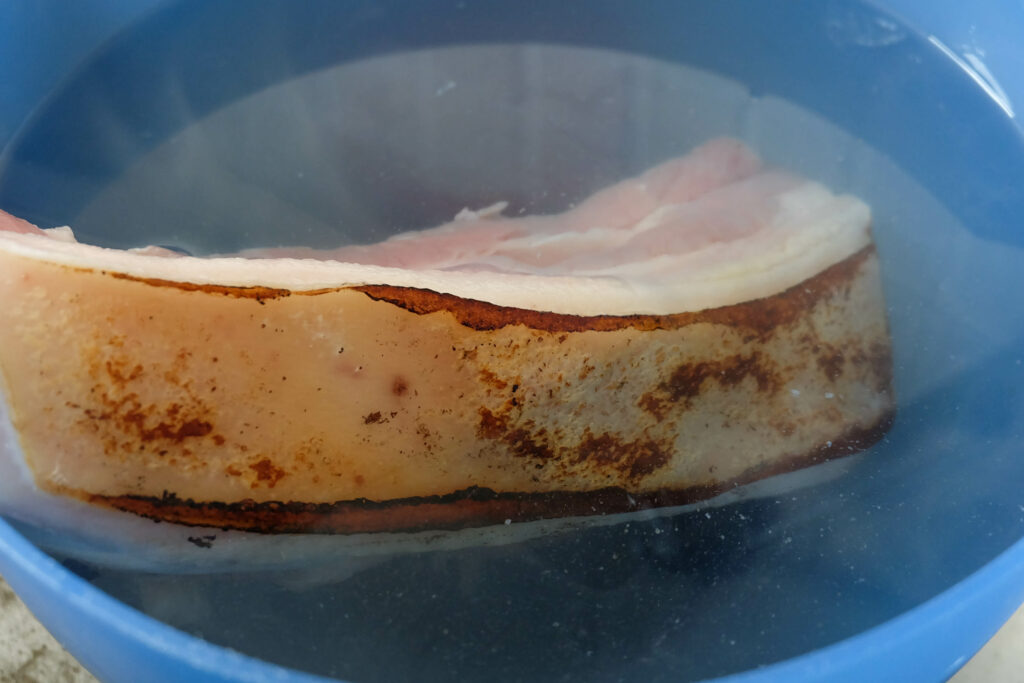
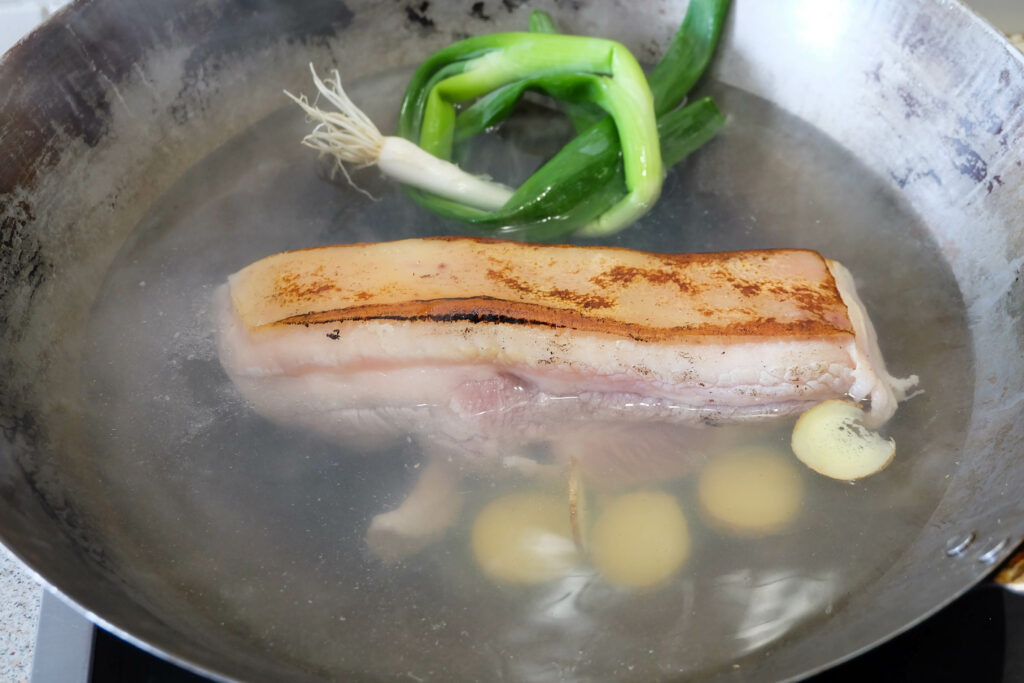

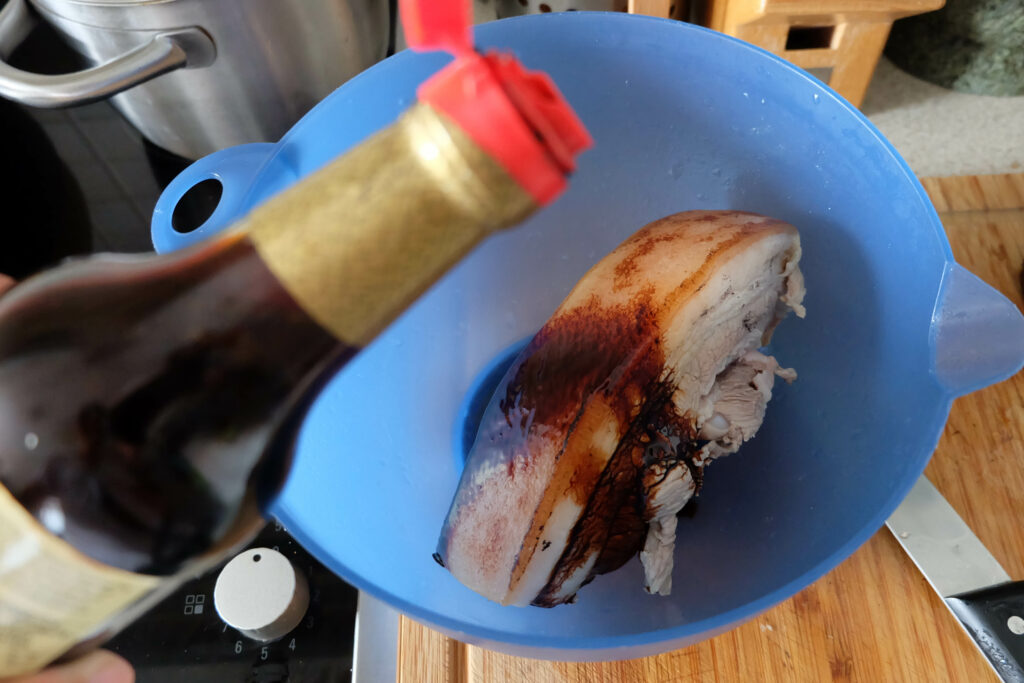
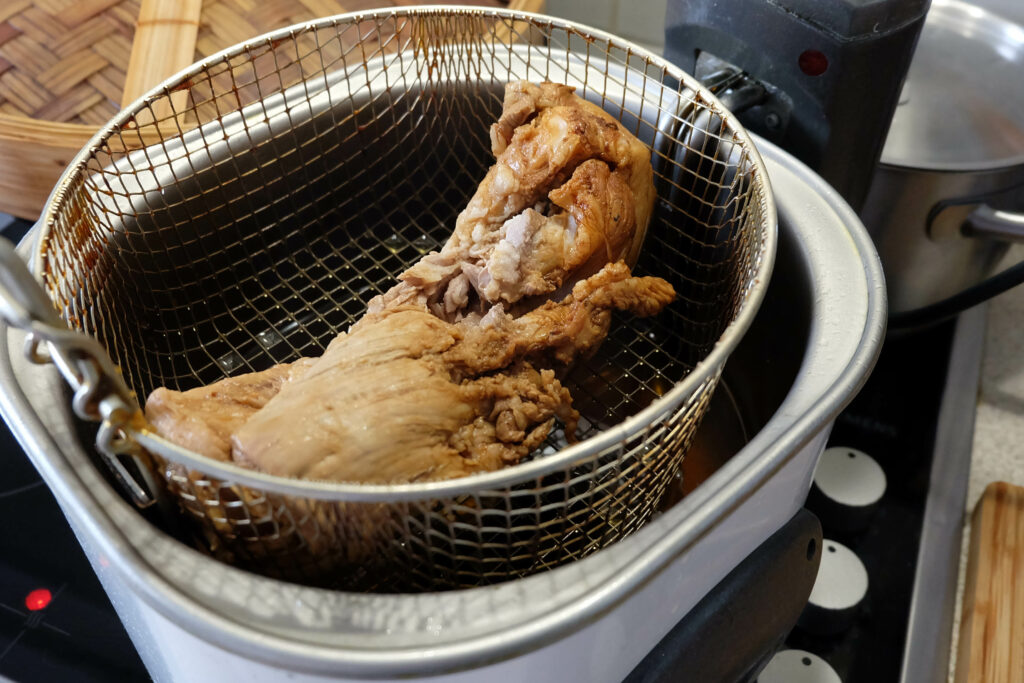
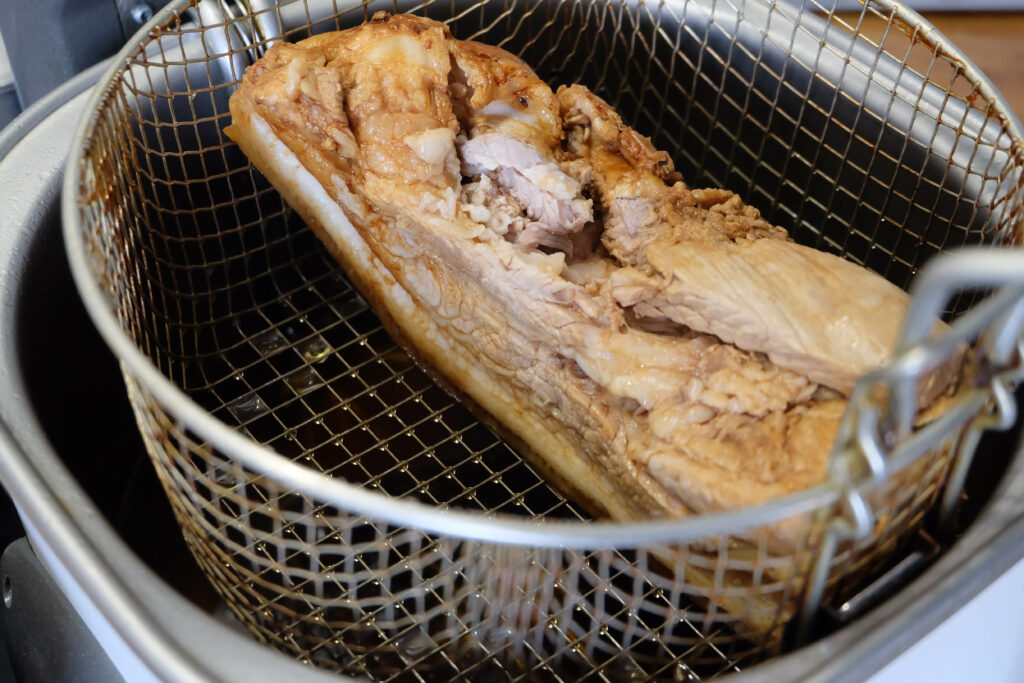
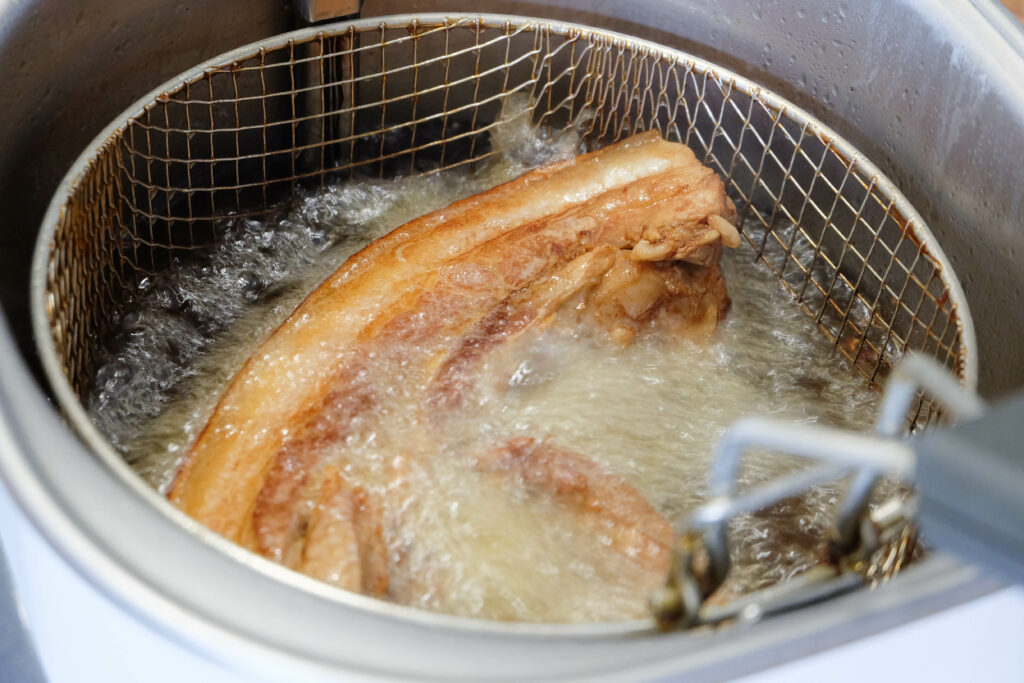
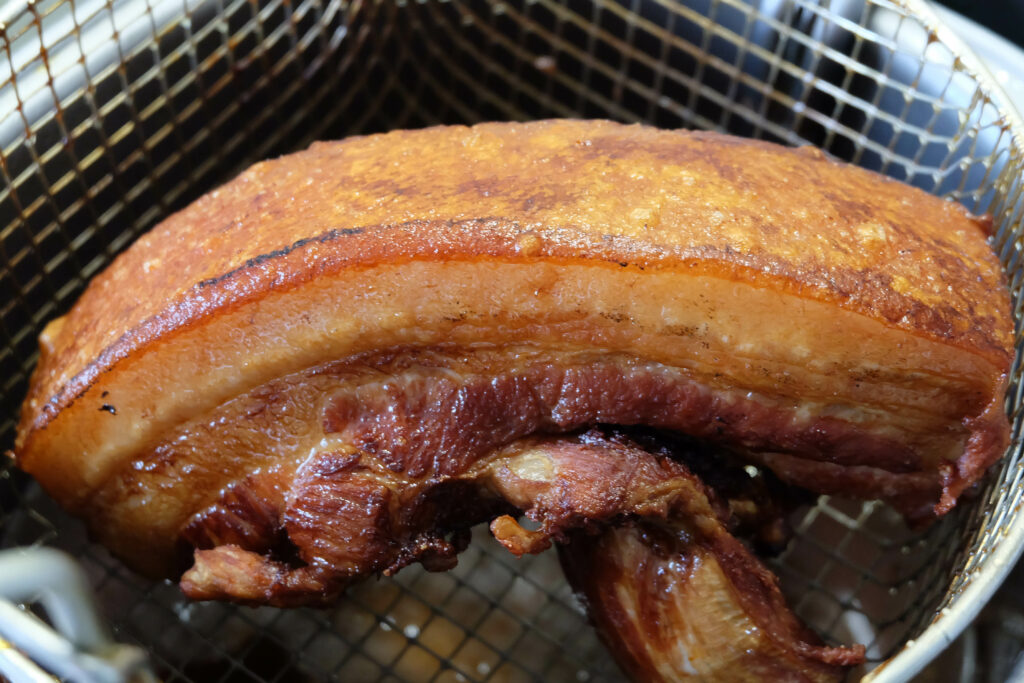
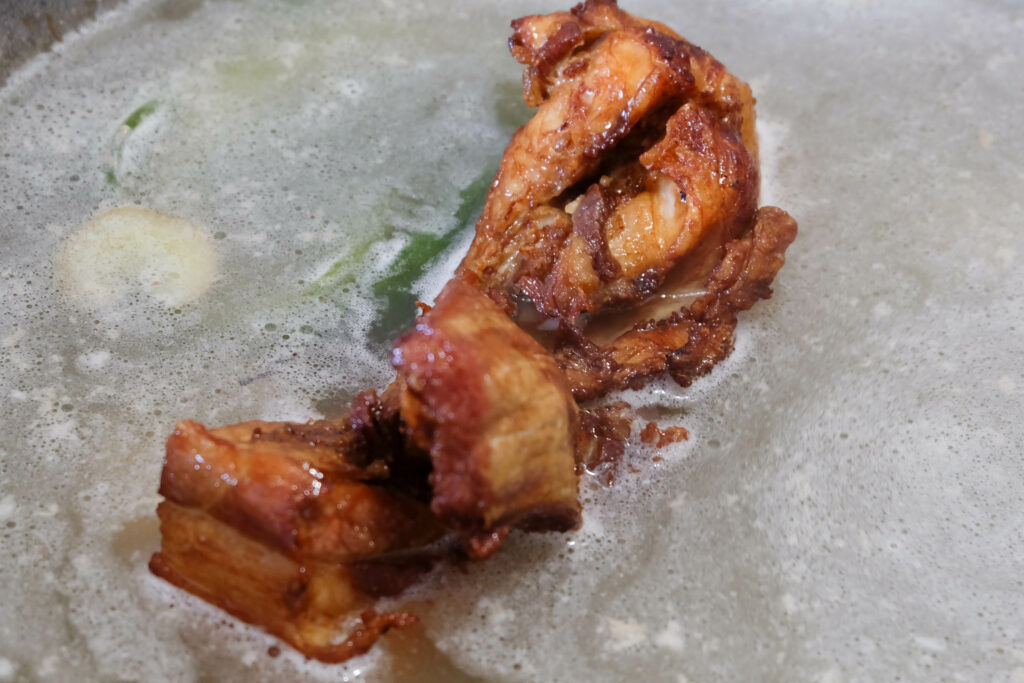

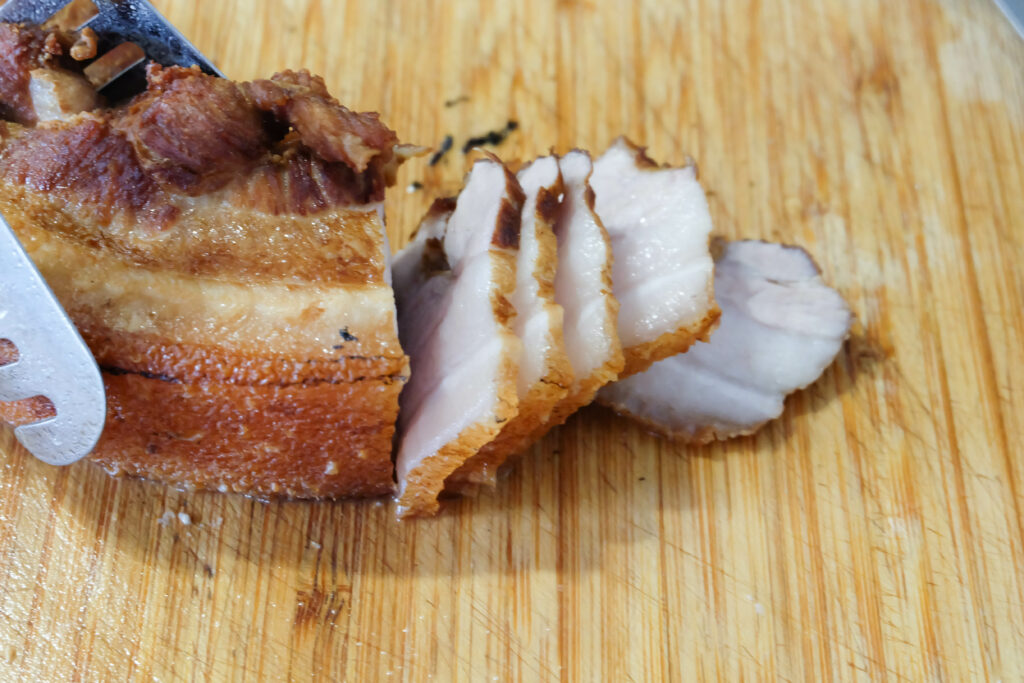
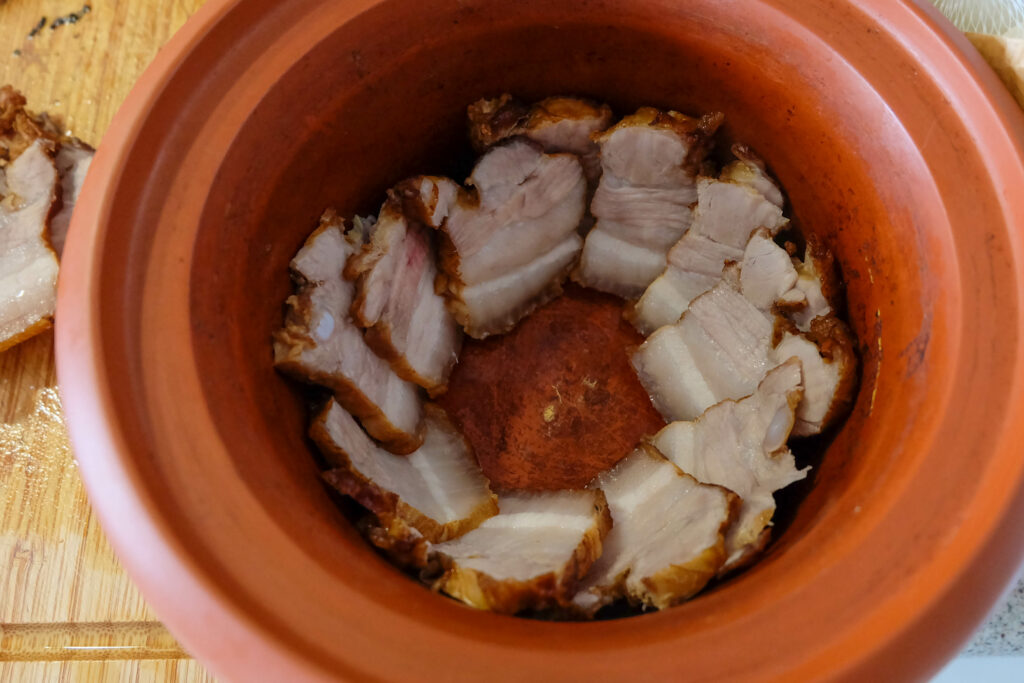

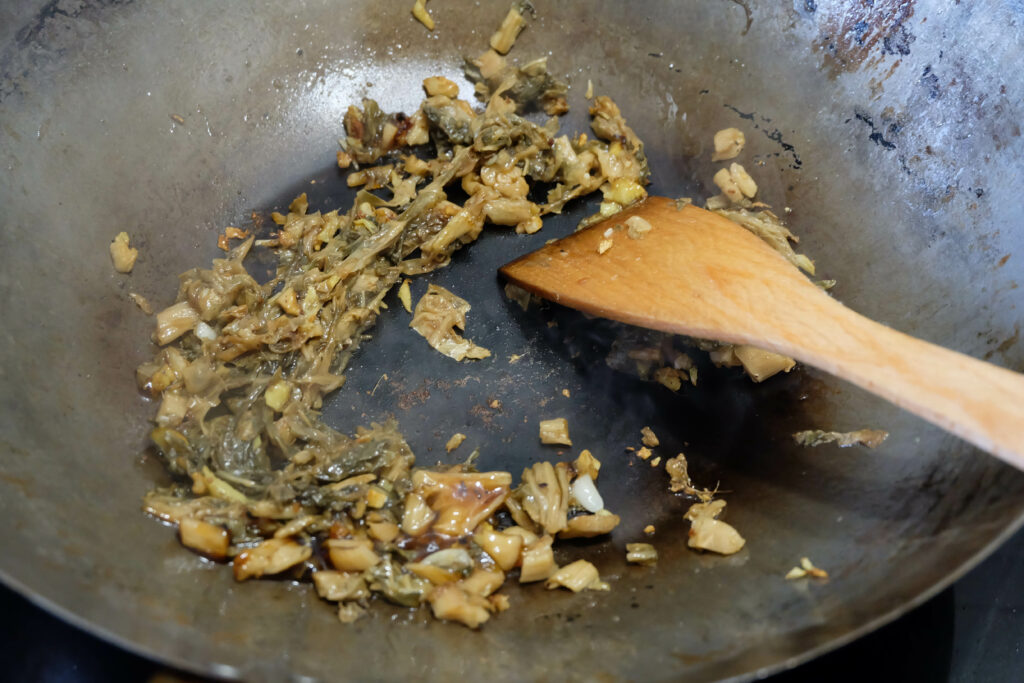
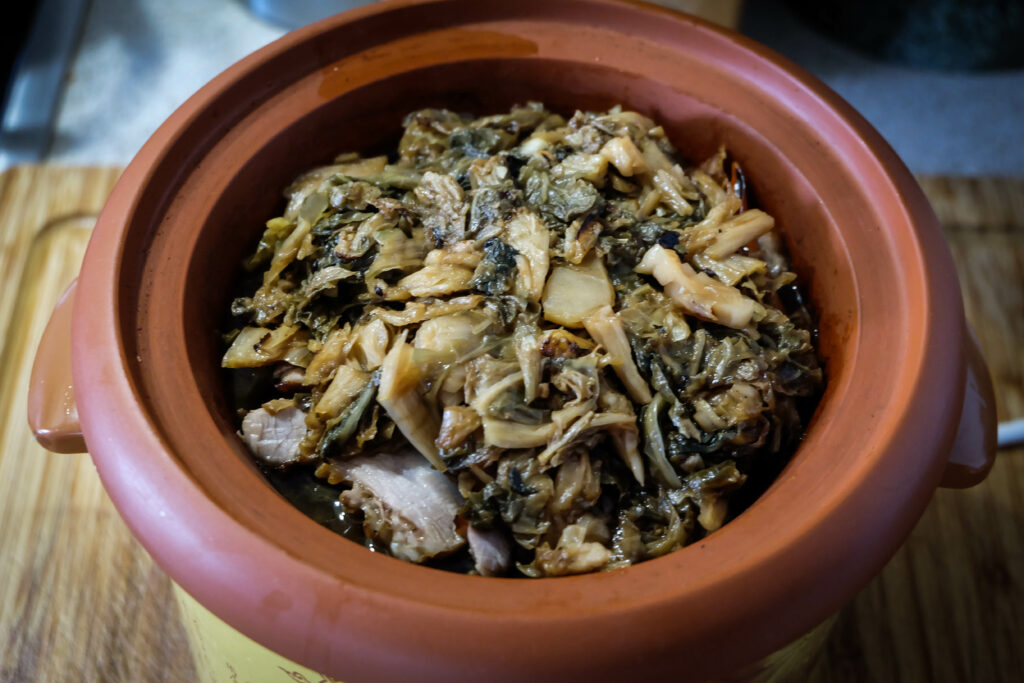
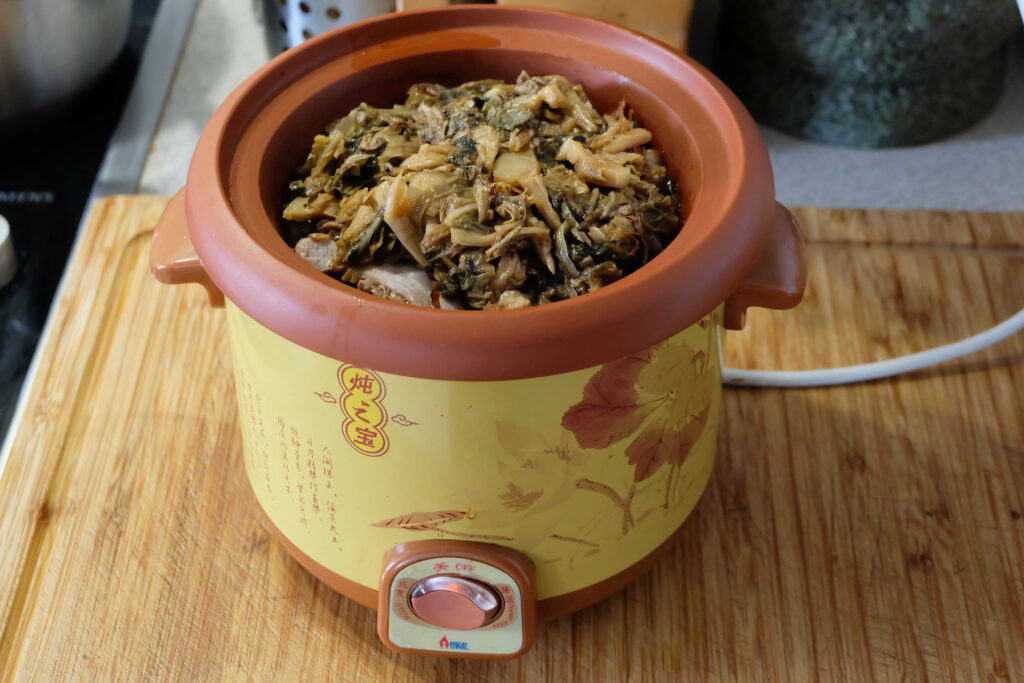

Deeply appreciate the deep dive into Hakka migration. The migration of Chinese diaspora throughout the world (and the inevitable evolution and adaptation of traditional dishes) has always been of great interest to me, myself being a third-generation Philippine-born Hokkien with siblings in France and Canada, distant cousins and their kids in Singapore, and various relatives sprinkled throughout the United States.
Hi there! Thanks for your comment! Oh yes, the Hokkien diaspora in the Philippines was massive, and Hokkien cuisine has brought ingredients and flavours to the local one creating new syntheses. Lumpia, Pancit yellow noodles.. are very Hokkien and they can be traced to one specific area: Zhangzhou. It’s wonderful that these are now part and parcel of Filipino cuisine. Greetings from Belgium!